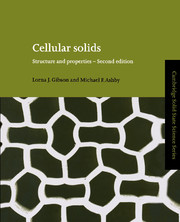Book contents
- Frontmatter
- Contents
- Preface to the second edition
- Preface to the first edition
- Units and conversion tables
- Chapter 1 Introduction
- Chapter 2 The structure of cellular solids
- Chapter 3 Material properties
- Chapter 4 The mechanics of honeycombs
- Chapter 5 The mechanics of foams: basic results
- Chapter 6 The mechanics of foams: refinements
- Chapter 7 Thermal, electrical and acoustic properties of foams
- Chapter 8 Energy absorption in cellular materials
- Chapter 9 The design of sandwich panels with foam cores
- Chapter 10 Wood
- Chapter 11 Cancellous bone
- Chapter 12 Cork
- Chapter 13 Sources, suppliers and property data
- Appendix: The linear-elasticity of anisotropic cellular solids
- Index
- References
Chapter 4 - The mechanics of honeycombs
Published online by Cambridge University Press: 05 August 2014
- Frontmatter
- Contents
- Preface to the second edition
- Preface to the first edition
- Units and conversion tables
- Chapter 1 Introduction
- Chapter 2 The structure of cellular solids
- Chapter 3 Material properties
- Chapter 4 The mechanics of honeycombs
- Chapter 5 The mechanics of foams: basic results
- Chapter 6 The mechanics of foams: refinements
- Chapter 7 Thermal, electrical and acoustic properties of foams
- Chapter 8 Energy absorption in cellular materials
- Chapter 9 The design of sandwich panels with foam cores
- Chapter 10 Wood
- Chapter 11 Cancellous bone
- Chapter 12 Cork
- Chapter 13 Sources, suppliers and property data
- Appendix: The linear-elasticity of anisotropic cellular solids
- Index
- References
Summary
Introduction and synopsis
The honeycomb of the bee, with its regular array of prismatic hexagonal cells, epitomizes a cellular solid in two dimensions. Here we use the word ‘honeycomb’ in a broader sense to describe any array of identical prismatic cells which nest together to fill a plane. The cells are usually hexagonal in section, as they are in the bee's honeycomb, but they can also be triangular, or square, or rhombic. Examples were shown in Fig. 2.3.
Man-made polymer, metal and ceramic honeycombs are now available as standard products. They are used in a variety of applications: polymer and metal ones for the cores of sandwich panels in everything from cheap doors to advanced aerospace components; metal ones for energy-absorbing applications (the feet of the Apollo 11 landing module used crushable aluminium honeycombs as shock absorbers); and ceramic ones for high-temperature processing (as catalyst carriers and heat exchangers, for example). And many natural materials – wood is one – can be idealized and analysed as honeycombs (as we do in Chapter 10). If such materials are to be used in load-bearing structures an understanding of their mechanics is important.
There is a second good reason for studying honeycombs: it is that the results shed light on the mechanics of the much more complex three-dimensional foams. Analysing foams is a difficult business: the cell walls form an intricate three-dimensional network which distorts during deformation in ways which are hard to identify.
- Type
- Chapter
- Information
- Cellular SolidsStructure and Properties, pp. 93 - 174Publisher: Cambridge University PressPrint publication year: 1997
References
- 23
- Cited by

